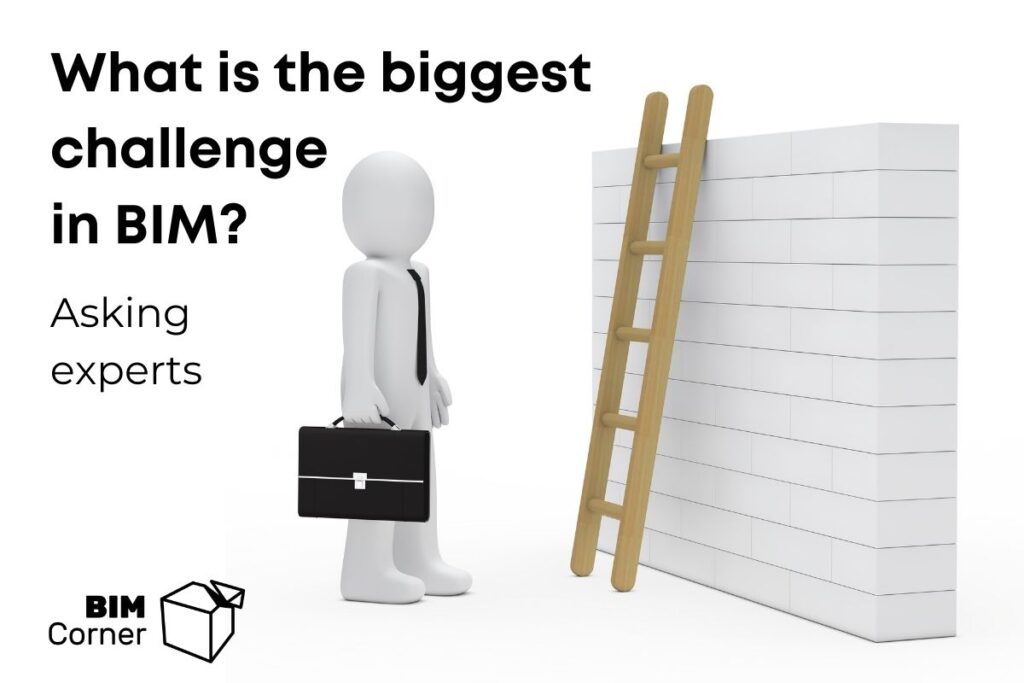All of our six work long enough in the industry to have their own opinions and thoughts (Konrad Naborczyk even wrote a post about it some time ago). In this entry, however, I want to give words to other professionals. I asked 10 experts to share their opinion and answer that question. They have different backgrounds and operate in different countries. They are ranging from BIM coordinators, managers, software vendors to salesmen and CEOs. Take a look at what their opinion is about that topic.
Experts and their opinions are ordered in alphabetical order.
The lack of clarity around what BIM is and how it should assist projects

|
Gavin Crump |
|---|---|
| Founder & BIM Consultant at BIM Guru | |
| Australia | |
| YouTube channel | |
I think there are many challenges facing BIM and the AEC industry in general, but one of the biggest ones is a lack of clarity around what BIM is and how it ‘should’ (not ‘can’) assist projects/clients.
We’re really only just waking up from more than a decade of ‘BIMwash’ by vendors and their evangelists, and it’s led to quite a muddy tapestry of options and approaches when it comes to the BIM process.
Our industry is naturally siloed, and firms rarely share intellectual property or look towards open source solutions that tend not to sweat the small stuff (e.g. most of them aren’t focused on a masonry hatch, but many firms cannot technically see past these types of things).
This is and will continue to lead to a divide in the types of firms and their understanding and application of BIM as time progresses. As clients become more well versed in what they need and expect of BIM, it will be harder for some firms to keep up or secure larger and more complex projects.
I encourage all firms to look beyond their platforms and focus on how BIM fits as a process in their organisation and its projects, then sculpt their technical approach around this. We’ve been doing the opposite as an industry for far too long now.
The lack of education and national standards

|
Rui Gavina |
|---|---|
| Partner/Digital Practice Manager at VN2R, | |
| Speaker Manager at BILT Committee - Europe | |
| Portugal | |
Knowledge, fees, tradition, contracts

|
Clive Jordan |
|---|---|
| Co-founder at Plannerly | |
| USA | |
| Plannerly website | |
I think each team has varying challenges:
- Owners: knowledge
- Architects: fees
- Engineers: tradition
- Contractors: contracts
We talk too little about what we should stop doing

|
Ole Kristian Kvarsvik |
|---|---|
| Managing Director at Rendra | |
| Norway | |
| StreamBIM website | |
BIM is constantly coming “in addition to”. Even though BIM is used in many of the processes in construction projects, we stick to old routines and processes that comes rather from the document-centre world. The underlying causes are complex, where, among other things, the legal lags behind. Drawings and documents are always the legal basis for deliveries, and “people get good at what they are measured on”. This in turn leads to the data quality in BIM being degraded, which in turn leads to declining confidence in BIM data.
As long as we drive with both a belt and braces, we won’t achieve the productivity growth and gains that lies in digital processes. We must talk about what we have to STOP doing. BIM doesn’t come in addition to – it comes instead of.
Digitization in the AEC industry must not focus on «electrifying paper», it must revolve around a model and data-centric approach in all processes with associated quality requirements.
Evolvement into true interoperability

|
Aidan Mercer |
|---|---|
| Marketing Director at buildingSMART International | |
| UK | |
| buildingSMART International website | |
Getting a BIM into the business

|
Adam Mohammadi |
|---|---|
| BIM Leader at JM | |
| Sweden | |
| BIM Podden podcast | |
The first part applies generally to the broad mass. That they should be able to evaluate the benefits of BIM. Get the BIM into the business. To be able to see the effect of BIM in different work steps on the company, which working methods are most useful.
As an example, what is the benefit of modelling in high detail?
Many people lack knowledge and analysis to concretely see the advantage of modelling in a certain way. They have no idea about the difference between LOD 200 and LOD 400, that analysis does not exist today. Still, the project may be required to be implemented in LOD 400. But no one really knows how LOD 400 will benefit their business. Further examples are Digital Twin, the Client asks to have their project as Digital Twin and pays for it, but in reality, the Property Owner does not really know the benefit of the Digital Twin.
The second part applies to employees who know BIM, the challenge for them is to link BIM with the company’s value chain. The focus with BIM is usually within Design and Production. But it is difficult to create value from the way of working in the early stages or the management of the property. Simply create an uninterrupted flow of information throughout the construction process.
The third part is to reach out to the broad and include the entire sector. In Sweden, for example, we have more than 15,000 companies that are members of the industry organization “Fastighetsägarna” (Swedish: Property Owners), more than 3,500 in the employers’ organization “Byggföretagen” (Construction companies), as well as more than 3,500 in the organization “Installatörsföretagen” (Building Services companies). Skanska, NCC, Peab and JM together account for about 25% of the construction. We must include at least all medium-sized companies, both among Builders and Contractors. Then maybe you can cover 50-60% of the market and then get more power and eventually get everyone involved. But in order to broaden, it is necessary to standardize and ensure that the standards are used and clarify the benefits to a greater extent and make it easy to achieve them.
Myths that disturbs in grasping the essence of BIM

|
Jurek Rusin |
|---|---|
| Chairman at buildingSMART Poland | |
| CEO/Founder at BIM Point/Multibim | |
| Poland | |
| buildingSMART Poland website | |
We need more respect for different involved disciplines and stakeholders

|
Frode Saltkjelvik |
|---|---|
| CTO at Graphisoft Norway | |
| Norway | |
| Graphisoft Norway website | |
The transition from traditional project planning to BIM project planning

|
Roberto Schiera |
|---|---|
| Area Sales Representative DACH at dRofus | |
| Germany | |
| dRofus website | |
The lack of digitally literate individuals

|
Håvard Vasshaug |
|---|---|
| Director at Reope | |
| Norway | |
| Reope website | |
From my point of view, the biggest challenge for the industry is the lack of digitally literate individuals working in it. So many people talk about digitization but very few people in the industry can make any digital tools. We need more people who actually work in the industry to create and own digital tools and processes and outsource less to the IT industry. This is also the biggest challenge for BIM.
A question for you
You have read many points of view. Do you agree with them, or do you stand in contrast to some (or all) of them? What is your opinion on the biggest challenges before BIM? Share it in the comment section below. I will choose some of the best and paste them into the main article. People will come and read them until all those challenges become merely a distant memory. 😉
















I agree with all opinions, but I think there is a problem with the meaning of BIM, please don´t misunderstand me, but I really think that BIM is software or technology instead of a process. Why do I believe that? If you see other industries, they already had this problem about adopting new tools/software and they solved with the concept of digital transformation (DX).
What is digital transformation (DX)? it is not about using new software, it is a changing process lead by digital data. Then there is 6 axis to take care of such as processes, organisation, culture, strategy, customers/partners and technology.
Other people think of BIM as a Lean tool to give a framework in which this tool works more than as software.
But if you really understand the concept of DX, BIM will become just a software lead by each axis. If you don’t take care of each axis “your BIM” will become just software in the same way as other industries think of DX as adopting new software.
I think you are right Victor, but you think it is a technology because it is linked to this technologies. We could say that BIM will really be here after the DX.
Is BIM an idea produced by the software? Who cares.
We can compare BIM with successful digital transformations.
Is the digital photography the camera, sensor and lens?
Or is it a software for image processing?
Neither of those.
First, you are taking a photo using a knowledge of your camera, sensor and lens to get best photo in particular situation like in traditional photography. Than you compare what you get, on the camera screen, with the scene and see instantly how deficiency of digital sensor impacts your photo. Than you recall how you can process photo in software to make it better, so you take another shot that better suits processing requirements. And then you think, and get new idea, and take new shot… Finally you opens your shots in some software and gets new ideas how to process them.
So, digital photography is completely new process that includes both camera and software, and most important, knowledge about all aspects of digital process to achieve best results.
When we achieve this level in BIM, we will have successful digital transformation in AEC.
I do Agree, since I am in a country that there is a huge lack of knowledge about BIM.
I did once a study on my colleagues and 50% of them thought that BIM is Revit or just related to Buildings.
If we want ti take the advantage of the technology and save the AEC industry, we have to spread out the knowledge about it.